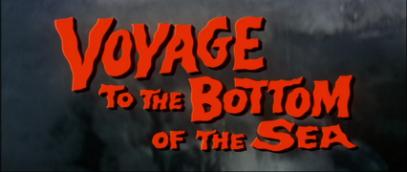|
|
| SEEN & SKIPPED: The Web of Death, Watership Down, The Water Margin, Warriors of Heaven & Earth, a whole bunch of Walt Disney Treasures collections, Walking With Dinosaurs, Waking Life and Waiting for Guffman . |
When I was a kid, it seems to my memory's (admittedly myopic) eye that there was a lot of science fiction on TV. Or perhaps I should say "sci-fi", because although that phrase drives Harlan Ellison up the nearest wall in second gear, it denotes to me a sort of entertainment that is long on the fiction (hopefully) but woefully short on the science. And a lot of this sort of material on TV in those days can be blamed on Irwin Allen.
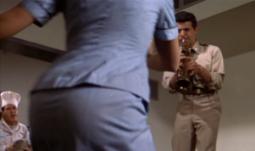 I was an avid fan of Lost in Space for the first couple of seasons, before it got too juvenile for me even at ten years of age. Like the recent - and unfortunate - movie version, it started out well, then self-destructed rather pathetically. But another Allen series also held my attention and occasionally managed to frighten the heck out of me, and that was Voyage to the Bottom of the Sea.
I was an avid fan of Lost in Space for the first couple of seasons, before it got too juvenile for me even at ten years of age. Like the recent - and unfortunate - movie version, it started out well, then self-destructed rather pathetically. But another Allen series also held my attention and occasionally managed to frighten the heck out of me, and that was Voyage to the Bottom of the Sea.
There are a lot of scenes from that series that had an impact on youthful me, remembered forever out of context; but one I recall with eerie distinctness was watching an episode called The Sky's On Fire, which had the Van Allen radiation belt around the Earth suddenly igniting and slowly constricting, threatening doomsday. The reason this is emblazoned in my memory is my mother complaining, "Oh, they just copied that from the movie." "Movie?" I asked. "Yeah, this was a movie before it was a TV show."
First I'd heard of it, or even considered such a thing. I could hear my horizons expanding in an almost audible manner. Within that year, ABC also ran that selfsame movie, and to my surprise, it left me rather... cold. And I couldn't figure out why. Surely, I figured, after thirty-some-odd years, I could revisit the movie and figure this out.
Uh-huh.
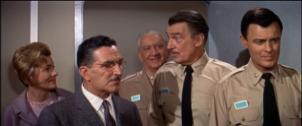 As the movie opens, Admiral Nelson ("one of the foremost scientific minds of our time" and Walter Pidgeon, to boot) is taking his new achievement, the nuclear super-submarine Seaview on its maiden voyage under the Arctic. He's also playing host to a psychiatrist, Dr.Susan Hiller (Joan Fontaine) who will be conducting a study on stress under submarine conditions, and an unsympathetic Congressman (Howard McNear), who was against the idea of America footing the bill for the Seaview. This rather neatly sets up the exposition, as Nelson and his righthand man, Captain Crane (Robert Sterling) take them on a tour of the sub.
As the movie opens, Admiral Nelson ("one of the foremost scientific minds of our time" and Walter Pidgeon, to boot) is taking his new achievement, the nuclear super-submarine Seaview on its maiden voyage under the Arctic. He's also playing host to a psychiatrist, Dr.Susan Hiller (Joan Fontaine) who will be conducting a study on stress under submarine conditions, and an unsympathetic Congressman (Howard McNear), who was against the idea of America footing the bill for the Seaview. This rather neatly sets up the exposition, as Nelson and his righthand man, Captain Crane (Robert Sterling) take them on a tour of the sub.
This provided my first two moments of wonderment: first, at the extremely casual way in which the men talk about Seaview's nuclear capabilities, and the second, that Floyd the Barber managed to get Mayberry to elect him to Congress. Ha ha, I kid, of course. This was a nice little role for character actor McNear, and obviously took place before the stroke that gave Floyd his distinctive delivery.
The tour allows us to also meet the rest of the major players: Commodore Emery (Peter Lorre!), yet another of the "foremost scientific minds of our time" (and introduced walking a anesthesized shark), Barbara Eden as Lt. Cathy, the Admiral's secretary (I didn't realize Navy uniforms included stilleto heels) and Frankie Avalon as Romano, the young spitfire semi-comic relief junior Lieutenant (well, come on, we knew Frankie was going to be involved after that sappy theme song under the opening credits).
Oh yeah, Cathy's also Crane's fiancee. There, I think we're set.
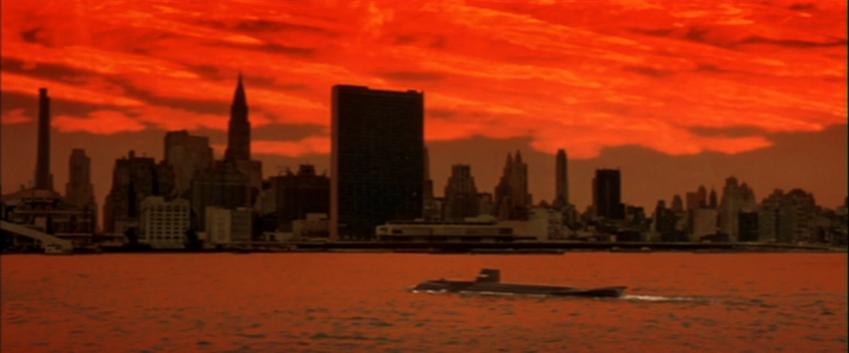 Well, not quite, but we're getting there. The shakedown cruise is interrupted when huge chunks of iceberg start pelting the submerged Seaview. Surfacing, they discover that the sky is literally on fire, the rapidly escalating temperature causing the men on the conning tower to ditch their arctic overwear. They also discover an unconscious man adrift on an ice floe, who turns out to be Alvarez (Michael Ansara), separated from the rest of his expedition when the ice began breaking up. There. Now we're set.
Well, not quite, but we're getting there. The shakedown cruise is interrupted when huge chunks of iceberg start pelting the submerged Seaview. Surfacing, they discover that the sky is literally on fire, the rapidly escalating temperature causing the men on the conning tower to ditch their arctic overwear. They also discover an unconscious man adrift on an ice floe, who turns out to be Alvarez (Michael Ansara), separated from the rest of his expedition when the ice began breaking up. There. Now we're set.
Nelson and Emery hole up in Nelson's stateroom, chain-smoking and filling up reams of paper with scientific calculations while Seaview hotfoots it to New York, so the two men can attend a meeting at the United Nations of the Foremost Scientific etc.'s. This august body is split into two groups: the ones who endorse Nelson's plan of blowing the Van Allen belt into space with a nuclear missile at exactly the right place at exactly the right time, and the ones who endorse a theory that the belt will burn itself out at 173 degrees Fahrenheit. The major problem is that 173 will occur in 17 days, and Nelson's window of opportunity is in 16 days. Having little more than two weeks to get halfway across the world, Nelson tells the UN to shove it and takes off for the Marianas Trench.
This is the thrust of the rest of the movie: the increasing atmospheric disturbance makes radio communication all but impossible, thwarting Nelson's attempts at getting a Presidential sanction for his mission; he continues to drive an increasingly disgruntled and mutinous crew toward that all-important spot on the map, a crew who would rather spend the remaining days with their families than buy into what seems to be a very slender and dubious chance of saving the world. There's drama in there, but somehow it seems to lack something on the screen.
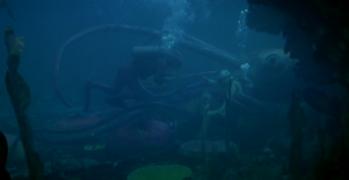 Likely, it is diffused by a rather episodic script; it seems an attempt at a one-damned-thing-after-another structure, but the incidents are so unrelated to each other, they never build up to a whole. Nelson's inability to raise the White House on radio leads them to tap into an underwater phone line, leading to a less-than-dramatic fight with an annoyingly inanimate giant squid. Running blind due to sabotage, the Seaview blunders into a minefield. More germaine to the story proper is an anonymous threatening note to Nelson, and a later attempt on his life; Dr. Hiller thinks that Nelson is beginning to Queeg out under stress and is staging the threats. She starts pressing Crane to declare Nelson incompetent and take over command of the sub.
Likely, it is diffused by a rather episodic script; it seems an attempt at a one-damned-thing-after-another structure, but the incidents are so unrelated to each other, they never build up to a whole. Nelson's inability to raise the White House on radio leads them to tap into an underwater phone line, leading to a less-than-dramatic fight with an annoyingly inanimate giant squid. Running blind due to sabotage, the Seaview blunders into a minefield. More germaine to the story proper is an anonymous threatening note to Nelson, and a later attempt on his life; Dr. Hiller thinks that Nelson is beginning to Queeg out under stress and is staging the threats. She starts pressing Crane to declare Nelson incompetent and take over command of the sub.
The discovery of a derelict pleasure ship out of Hawaii gives Nelson the chance to let the more mutinous crew members attempt to return home, a decision driven more by the newspaper found on the ship - basically, a bounty has been placed on the Seaview, and all the other subs in the world have been ordered to stop it before it can fire the missile. Crane's hand is finally forced by - of all things - Nelson slapping Romano after the lieutenant mouths off to him. Cripes, who hasn't wanted to slap the hell out of Frankie Avalon at one point or another? In any case, Crane tries to arrest Nelson at exactly the moment that a UN sub attacks - only one? Cripes, Nelson literally broadcast the coordinates of their destination on live TV! Closely followed by a giant octopus, because you can't have an undersea sci-fi thriller without a giant octopus. (And 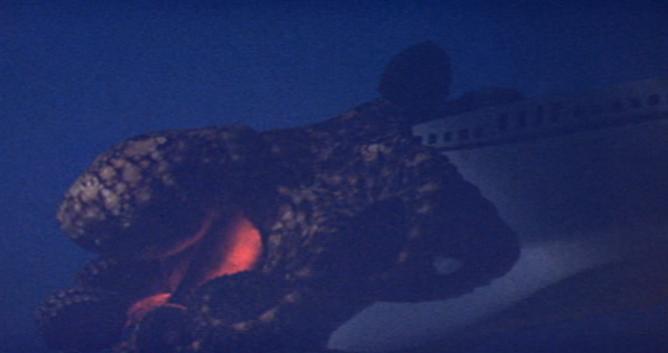 unless the controls on the Seaview are far more sophisticated than I had imagined, there is a human hand on the rear end of the sub trying to shake the octopus off)
unless the controls on the Seaview are far more sophisticated than I had imagined, there is a human hand on the rear end of the sub trying to shake the octopus off)
These incidental antics - the squid, the minefield, the octopus - really start to tick you off when the saboteur is finally revealed, only to be immediately eaten by Emery's pet shark before any motive can be discerned (and here is the spoiler asterisk: * ) . Why are we suddenly in a hurry?
Chances are this made a much better 60 minute episode than a 105 minute feature film, because the TV episode focussed on the bits of the story that actually had something to do with the central plot. The fact that it could also use the footage from the higher-budgeted movie version was a bonus. It also had to be re-imagined into the world of the TV series, because I can see a lot of repercussions from the events in the movie. For instance, I can imagine a drunken Nelson telling a cringing Crane, "Hey, remember that time you were gonna arrest me and let the world end?"
Nelson makes an incredibly Heinleinian hero - he quickly perceives The Right Thing To Do, and he is going to by-God do it, the rest of you blithering fools can slowly cook in a world that is rapidly becoming an Easy-Bake Oven. A little bit of doubt might have been nice for the character, though we do have a moment of almost Marcus Brutus-type tragedy when he feels that by letting the mutineers go home, he is rid of the saboteur. Man, foremost scientific minds of our time can be such dummies. As Nelson, Walter Pidgeon is... Walter Pidgeon. And that's sufficient.
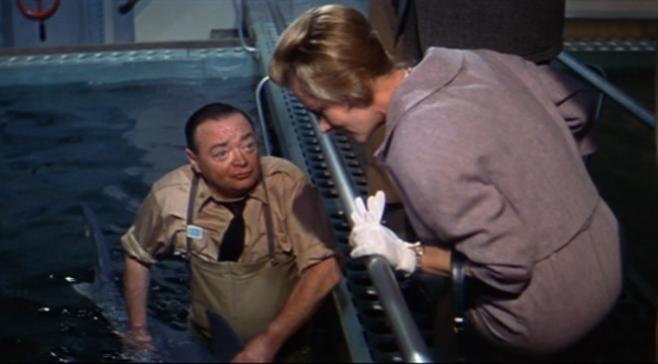 Speaking of foremost etc.'s, Peter Lorre is a refreshing breath of fresh air in the proceedings. Impressively, he's a dour, lovable presence throughout most of the picture, though his line load is sadly light. His best moment is when, at the United Nations, he snaps at Dr. Zucco and his 173 degrees theory, and immediately afterwards mutters, "...he just irritates me so much..." Probably ad-libbed. You have to love this man. It is ordained by bad movie law.
Speaking of foremost etc.'s, Peter Lorre is a refreshing breath of fresh air in the proceedings. Impressively, he's a dour, lovable presence throughout most of the picture, though his line load is sadly light. His best moment is when, at the United Nations, he snaps at Dr. Zucco and his 173 degrees theory, and immediately afterwards mutters, "...he just irritates me so much..." Probably ad-libbed. You have to love this man. It is ordained by bad movie law.
Speaking of loving, Barbara Eden refined the qualities of Bright and Perky to an exact science, and her apparently innate ability to make you instantly love her is so dangerous, it has been the focus of several Senate sub-committee hearings. Lt. Cathy made not have made the leap to the TV series (not wearing those heels, she couldn't), but that just meant we could all grow up hearing Eden brightly chirp "Master" to a very lucky and slightly embarrassed Larry Hagman.
So maybe I have figured out why Voyage to the Bottom of the Sea left me so cold many years ago - and why it still does so now, even though, as 60's era science-fiction, I should be eating it with a spoon and asking for more. It is family-friendly, I give it that, like most high-profile genre films of its time. But let's face it, I was ten years old when I first saw it, and could at least sense the holes, if not put my fingers in them and wiggle them around. Well-made as the movie is, craftwise, I fear that the best thing I can say about it is the faintly damning, it's an okay movie. Not great, but okay.
At least I didn't say it was sub-standard. Cut me some slack.
RATING:
![]()
![]()
![]()
*Sigh* It's an okay movie.
- August 22, 2004

